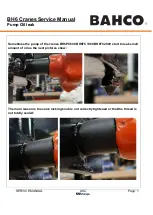
18
8. Fully insert the new hinge pin into the splice. Use the
hinge pin to push the steel rod out of the splice.
NOTE: The steel rod provides splice alignment.
9. Making sure the hinge pin does not stick out beyond either
edge of the belt, crimp both ends of the splice so the
hinge pin cannot work its way out of the splice.
10. Tension the belt at the front rollers by equally tightening
the front tensioning bolts. Using a torque wrench, tighten
each of the front tensioning bolts to approximately 35 ft-
lb (4.8 kg-m). This is a “ballpark” value since the belt
will expand and contract with temperature changes.
Ultimately, the best method of tensioning is to have it
just tight enough to not slip while unloading material.
11. Test the belt for proper alignment by running the conveyor.
Make small adjustments to the tensioning bolts for this
belt alignment fine tuning.
15. When the alignment and tensioning are complete, secure
the adjustment by tightening the jam nuts.
Regular Maintenance
Regular maintenance of the conveyor system consists of:
1. Regularly clean and wash the hopper and conveyor
especially if hauling potentially corrosive materials such
as fertilizer.
2. Keep belt tight when in use.
3. Loosen belt at the front rollers when Turf Tender is not
going to be used for an extended period of time. The belt
contracts a significant amount as its temperature drops so
loosening the belt for winter storage is important.
4. Periodically check belt for tears and wear.
5. Never allow hydraulic fluid to come in contact with the
belt. It is made of PVC which provides resistance to
fertilizers and other agricultural chemicals but has little
resistance to hydraulic fluid.
DUAL SPINNER SPREADING SYSTEM
Regular Maintenance
Periodically check the hydraulic hoses for worn areas and
other unsafe conditions (cracks or leaks). This should be part
of the safety walk around each time before using the Turf
Tender. Pinhole leaks under pressure can pierce skin and inject
hydraulic oil under your skin. Never handle hoses while the
hydraulic system is pressurized.
Whenever changing spinner blades, thoroughly clean the
spinner shafts before installing a different set of spinners. This
prevents a buildup of dirt, grease, and other materials. After
cleaning, apply Anti-Seize to the shafts.
ELECTRICAL SYSTEM
NOTE: Electrical schematics are available upon
request. If electrical problems are experienced,
contact either your dealer or Dakota Peat.
Overview
The Turf Tender electrical system obtains its power from
the engine battery. The engagement handle uses micro switches
to control the engagement of the electric clutch on the engine.
If the Turf Tender loses all functions, troubleshoot the battery,
battery cables, the microswitches, or the electric clutch.
Wiring
All wiring conforms to SAE J1128 standards low tension,
PVC insulated, stranded copper wire. The PVC insulation has
a 176ºF (80ºC) temperature rating. It is important that wires
not be routed through areas having high temperatures.
Exposed wires are also encased in black, abrasion-resistant
looming wherever possible. The working temperature range
of the loom is -34º to 200ºF (-34º to 93ºC). Again, since this a
low temperature plastic, it is important that the wires are not
routed near areas with high temperatures.
MAINTENANCE



































